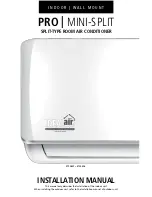
Component Operation and Maintenance
42
6.0
C
OMPONENT
O
PERATION
AND
M
AINTENANCE
6.1
System Testing
6.1.1 Environmental Control Functions
The performance of all control circuits can be tested by actuating each of the main functions. This is
done by temporarily changing the setpoints.
Cooling
To test the cooling function, set the setpoint for a temperature of 10°F (5°C) below room temperature.
A call for cooling should be seen and the equipment should begin to cool. A high temperature alarm
may come on. Disregard it. Return setpoint to the desired temperature.
Heating
Reheat may be tested by setting the setpoint for 10°F (5°C) above room temperature. A call for heat-
ing should be seen and the heating coils should begin to heat. Disregard the temperature alarm and
return the setpoint to the desired temperature.
Humidification
To check humidification, set the humidity setpoint for an RH 10% above the room humidity reading.
For infrared humidifiers, the infrared element should come on. For steam generating humidifiers, you
will immediately hear the clicks as it energizes. After a short delay, the canister will fill with water.
The water will heat and steam will be produced. Return the humidity setpoint to the desired humidity.
Dehumidification
Dehumidification can be checked by setting the humidity setpoint for an RH 10% below room relative
humidity. The compressor should come on. Return humidity setpoint to the desired humidity.
Proportional Heating/Cooling/ Dehumidification
On Chilled Water, GLYCOOL (Econ-O-Cycle, Free Cool, GLYCOOLING cycle) models, and models
with hot water reheat, the microprocessor is capable of responding to changes in room conditions.
These systems utilize either a 2- or 3-way valve activated by a proportioning motor.
For cooling and dehumidification, the microprocessor will respond by positioning the valve propor-
tionally to match the needs of the room. Full travel of the valve takes place within the range of the
sensitivity setting. During dehumidification, full travel of the valve takes place within 2% RH.
For hot water reheat, the microprocessor will respond by positioning the hot water valve proportion-
ally to match the needs of the room. Full travel of the valve takes place within 1°F with each 0.1°F
resulting in 10% valve travel.
Electric Panel
The electric panel should be inspected for any loose electrical connections.
Control Transformer and Fuses
The control system is divided into four separate circuits. The control voltage circuits are individually
protected by fuses located on the transformer/fuse board. If any of the fuses are blown, first eliminate
shorts, then use spare fuses supplied with unit. Use only type and size of fuse specified for your unit.
The small isolation transformer on the board supplies 24 volts to the main control board. The trans-
former is internally protected. If the internal protector opens, the transformer/fuse board must be
replaced. Also check the control voltage fuse on the main control board before replacing the trans-
former/fuse board.
Fan Safety Switch
The Fan Safety Switch is located in the low voltage compartment and consists of a diaphragm switch
and interconnecting tubing to the blower scroll. The Fan Safety switch is wired directly to the control
circuit to activate the alarm system if the airflow is interrupted
!
CAUTION
Be sure that power to the unit is shut down before attempting to tighten any
fittings or connections.
Содержание CHALLENGER 3000
Страница 2: ......
Страница 8: ...vi ...
Страница 74: ...Semiannual Maintenance Inspection Checklist 66 ...
Страница 75: ......
















































